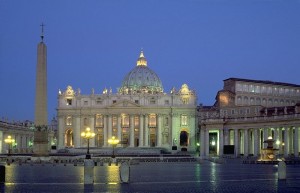 “Introibo ad altare Dei“: Document on How to Implement Summorum Pontificum Published in Rome Today, May 13, 2011
“Introibo ad altare Dei“: Document on How to Implement Summorum Pontificum Published in Rome Today, May 13, 2011
A day of rejoicing for Catholics who love the rich, profound tradition of the old Latin liturgy.
A day — May 13, 2011 — which, bracketed with July 7, 2007, when the Pope published Summorum Pontificum, will take its place in Church history, as Benedict patiently continues one of the central tasks of his pontificate, the “reform of the reform” in the supremely important matter of the Church’s liturgy, her worship of God.
Today, on the 94th anniversary of the first appearance of Our Lady of Fatima on May 13, 1917, the “old Mass,” seemingly set aside forever in 1970, received a new lease on life.
In a document entitled Universae ecclesiae (“To the Universal Church”) and dated April 30, 2011 — the memorial of Pope St. Pius V, author of the bull Quo Primum (July 14, 1570) by which the old of “Tridentine” liturgy was codified after the Council of Trent — Pope Benedict issued clear guidelines defending and protecting the use of the old rite of the Mass.
In fact, the document suggests that it is inappropriate to continue to call the Tridentine rite the “old Mass,” as Benedict is teaching that is still very much the liturgy of the Church today, so I will refer to it from now on as “the ever new traditional Mass,” basing myself on Pope Benedict’s own words from the document: “What was sacred for prior generations, remains sacred and great for us as well.
And so Pope Benedict, in this document, seems to have definitively “rehabilitated” the ever new traditional liturgy.
I say “seems” because there are still a few passages and phrases in this document which suggest that Benedict had to “tip-toe” between Church groups which support and oppose the ever new traditional liturgy.
I note especially the passage where he says that priestly ordinations in the ever new traditional rite are only to be celebrated in religious orders which are under the Pontifical Commission Ecclesia Dei — not very many.
Here is the passage, which is at the end of the document released today (Paragraph 31): “Only in Institutes of Consecrated Life and Societies of Apostolic Life which are under the Pontifical Commission Ecclesia Dei, and in those which use the liturgical books of the forma extraordinaria, is the use of the Pontificale Romanum of 1962 for the conferral of minor and major orders permitted.”
This restriction of the use of the traditional ordination rite seems a contradiction to me, if the traditional liturgy is actually to be honored as “sacred and great” for us.
And there is a rather labored treatment of the need for a “stable group” of Catholic who wish to attend Mass in the ever new traditional rite in order for its regular celebration to be permitted. (See Paragraph #15, which speaks of a coetus fidelium (“group of the faithful”)… stabiliter existens (“existing in a stable manner”).
This clause, which dates back to Summorum Pontificum, suggests that the ever new traditional rite is not really “sacred and great” and so to be celebrated with joy in all of the parishes of Christendom, but still somehow an inconvenient leftover from a period of Church history which has been left behind, to be celebrated only when a group of faithful actually, and insistently, request it.
This too seems a contradiction to me.
But aside from these points, which I think reflect the intense opposition to a return to the ever new traditional liturgy, the document does set forth a powerful case for the continued use of the older, deeply revered liturgy throughout the Church.
And this is cause for celebration, for something precious which had been generally forgotten, or abandoned, is in this document being recovered, preserved, and honored.
Benedict stresses the following points regarding the ever new traditional liturgy:
(1) The ever new traditional liturgy is to be protected and honored because it is orthodox and protects the orthodox belief of the faithful (see Paragraph #3: “the usages universally handed down by apostolic and unbroken tradition… are to be maintained not only so that errors may be avoided, but also so that the faith may be passed on in its integrity, since the Church’s rule of prayer (lex orandi) corresponds to her rule of belief (lex credendi).”)
(2) The newer Mass of Paul VI, which seemed to replace the ever new traditional rite, is also valid (see Paragraph #6: “they are two usages of the one Roman Rite, one alongside the other. Both are the expression of the same lex orandi of the Church”), but the ever new traditional liturgy has a certain “pride of place” in our tradition due to its antiquity (again, see Paragraph #6: “On account of its venerable and ancient use, the forma extraordinaria is to be maintained with appropriate honor.”)
(3) Every priest in the Catholic Church has the right to celebrate the ever new traditional liturgy alone without any permission needed.
(4) The Pontifical Council Ecclesia Dei (“Church of God”) is given extraordinary powers, and named “vicar” of the Pope for liturgical disputes (See Paragraph #9: “The Sovereign Pontiff has conferred upon the Pontifical Commission Ecclesia Dei ordinary vicarious power for the matters within its competence, in a particular way for monitoring the observance and application of the provisions of the Motu Proprio Summorum Pontificum.”).
This means that the Ecclesia Dei commission is not under any other Vatican body, not even the Secretariat of State, but directly under the Pope alone, in handling these matters regarding the liturgy.
Here is the text of this historic document, published on this historic date.



